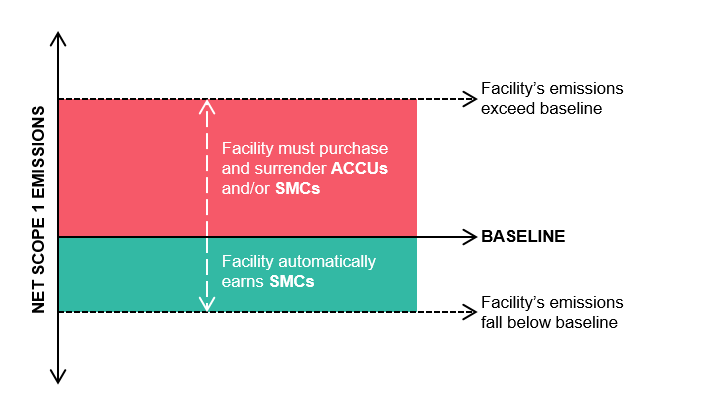Australian Government ramps up climate reforms: Safeguard Mechanism overhaul begins with new carbon credits
28 November 2022
In keeping with significant recent reforms to national climate law and policy, the Australian Government has released an exposure draft of the Safeguard Mechanism (Crediting) Amendment Bill 2022 (Cth) (the Draft Bill) and accompanying draft Carbon Credits (Carbon Farming Initiative) Amendment (Safeguard Facility Eligibility Requirements) Rules 2022 which, if passed, would introduce a new Australian carbon credit targeted at incentivising drastic emissions reduction among Australia’s largest greenhouse gas emitters.
The Draft Bill represents a glimpse of the potential amendments to the Safeguard Mechanism.
Proposed changes to the Safeguard Mechanism set to increase compliance requirements for high emitters
The Safeguard Mechanism is a mandatory decarbonisation framework introduced in 2016 with the aim to reduce Australia’s national greenhouse gas emissions.
The Safeguard Mechanism sets limits on net direct (Scope 1) CO2-e emissions – called baselines– that certain Australian industrial facilities must meet by reducing their operational emissions and offsetting any remaining emissions through the purchase and surrender of carbon credits.
Currently, the Safeguard Mechanism only applies to Australian industrial facilities that release at least 100,000 tonnes of Scope 1 emissions per annum. In practical terms, this equates to coverage of approximately 215 firms. These firms are spread across all sectors of the economy and accounted for around 28 per cent of Australia’s total greenhouse gas emissions between 2020 and 2021.
The Safeguard Mechanism in its current form has been criticised as ineffective, in particular as current baselines have significant ‘aggregate headroom’ – ie, the combined baselines are set well above the actual total emissions output of the covered facilities. This means that the Safeguard Mechanism is not currently achieving an actual net abatement.[1]
Key changes considered
The reforms aim to gradually reduce Safeguard Mechanism baselines at indicative decline rates of 3.5 to 6 per cent each year and thereby force abatement activities to occur. As a precursor, the Australian Government sought general feedback from industry on a number of key changes proposed in its Consultation Paper, including:
- the extent to which the Safeguard Mechanism should contribute to Australia’s national climate targets. The Consultation Paper suggests that, if the Safeguard Mechanism contributed to national reductions targets in the proportion to which covered facilities contribute to Australia’s total CO2-e emissions, aggregate baselines would need to sit at 99 Mt CO2-e by 2030;
- whether baselines should be fixed at an absolute level or remain dynamic, based on the amount of CO2-e each facility emits on average for each unit it produces. The latter specifically incentivises improving the emissions intensity of a facility’s particular product or service, and avoids penalising facilities for increasing their business output.
- whether the current aggregate headroom should be removed immediately so that baselines are reset to have a starting point equal to the current actual aggregate emissions output of covered facilities. Removing the headroom now would mean facilities would have to start abatement activities immediately, but that baselines would not have to fall as steeply over the next eight years to meet target aggregate baselines of 99 Mt CO2-e by 2030;
- how baselines should be set for new facilities that meet the coverage threshold. The Consultation Paper proposes either an industry average approach, or a new best practice calculation based on the average emissions intensity of the top 10 per cent of Australian industry is adopted. At present, the coverage threshold of 100,000 tonnes of Scope 1 emissions per annum will remain in place;
- how ‘emissions-intensive, trade exposed facilities’ – ie, those facilities that face higher costs in reducing emissions but might struggle to manage those costs due to the price of their output being set in global markets – might be supported through particular concessions. The justification for concessions would be to avoid disadvantaging domestic businesses and driving production (and associated emissions) overseas;
- how credits and offsets should be used under the amended Safeguard Mechanism (see the detailed discussion below); and
- what characteristics the decline trajectory to 2030 should have, including whether the reduction of baselines should be linear from the outset or have a soft start.
The new Safeguard Mechanism Credit (SMC)
As baselines decrease, it can be expected that pressure will increase on carbon markets as facilities unable to adequately reduce their Scope 1 emissions look to purchase and surrender carbon credits to comply with more stringent targets.
In order to incentivise facilities cutting back their operational emissions as much as possible, the Government will introduce new SMCs, which will automatically be credited to facilities in proportion to how far their emissions fall below the baseline.
These SMCs will not be eligible for use outside the Safeguard Mechanism since they are not additional — ie, the abatement they represent is already considered to be mandatory under the Safeguard Mechanism. However, SMCs will be able to be sold to other Safeguard Mechanism facilities and surrendered for the purpose of meeting baseline targets, in addition to Australian Carbon Credit Units (ACCUs).

The Draft Bill makes it clear that SMCs will be subject to the same rules as ACCUs in respect of their registration, transfer and surrender.
The Consultation Paper suggests that only domestic carbon credits (ie, ACCUs and SMCs) will be eligible for use under the Safeguard Mechanism. This means that voluntary international carbon credits, such as those issued by non-government bodies like VERRA and Gold Standard, cannot be used towards baselines. However, this policy may change as international carbon trading markets, including for example that proposed under the Indo-Pacific Carbon Offsets Scheme, become more developed and robust.
It is unclear at this stage how the independent review of ACCUs, currently being led by Professor Ian Chubb in response to public concerns regarding the integrity of ACCUs, may affect the reforms.
Next steps
Consultation on the Draft Bill was only open for a short time and has now closed.
However, Australian companies whose facilities currently fall within the Safeguard Mechanism scheme — or who are likely to be subject to the regime in the future — may still wish to provide feedback, and consider options to meet indicative decline rates in the coming years.
The potential reforms will play a crucial role in the Australian Government’s strengthened commitment — now reflected in a suite of national environmental legislation following the recent passing of the Climate Change Act 2022 (Cth) and accompanying Climate Change (Consequential Amendments) Act 2022 (Cth) — to reduce national emissions by 43% below 2005 levels by 2030, and achieve net zero emissions by 2050.
[1] Australian Government Department of Climate Change, Energy, the Environment and Water, Safeguard Mechanisms Reforms (Consultation Paper, August 2022) 11-12.
Authors

Partner
Law Graduate
Tags
This publication is introductory in nature. Its content is current at the date of publication. It does not constitute legal advice and should not be relied upon as such. You should always obtain legal advice based on your specific circumstances before taking any action relating to matters covered by this publication. Some information may have been obtained from external sources, and we cannot guarantee the accuracy or currency of any such information.
Key Contact
Other Contacts
Head of Environment and Planning

